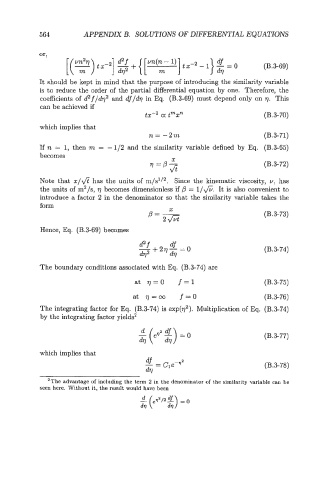Page 584 - Modelling in Transport Phenomena A Conceptual Approach
P. 584
564 APPENDIX B. SOLUTIONS OF DIFFERENTIAL EQUATIONS
or.
It should be kept in mind that the purpose of introducing the similarity variable
is to reduce the order of the partial differential equation by one. Therefore, the
coefficients of d2 f /dq2 and df /dq in Eq. (B.3-69) must depend only on q. This
can be achieved if
tx-' a tmzn (B.3-70)
which implies that
n=-2m (B.3-71)
If n = 1, then m = - 1/2 and the similarity variable defined by Eq. (B.3-65)
becomes
v=P-J 2 (B.3-72)
Note that x/& has the units of m/s'I2. Since the kinematic viscosity, v, has
the units of m2/s, q becomes dimensionless if fl = I/&. It is also convenient to
introduce a factor 2 in the denominator so that the similarity variable takes the
form
p=- 2 (B .3- 73)
2-
Hence, Eq. (B.3-69) becomes
(B.3-74)
The boundary conditions associated with Eq. (B.3-74) are
at q=O f=1 (B.3-75)
at q=oo f=O (B.3-76)
The integrating factor for Eq. (B.3-74) is exp(q2). Multiplication of Eq. (B.3-74)
by the integrating factor yields2
g 5) = 0 (B.3-77)
($2
which implies that
(B.3-78)
2The advantage of including the term 2 in the denominator of the similarity variable can be
seen here. Without it, the result would have been

